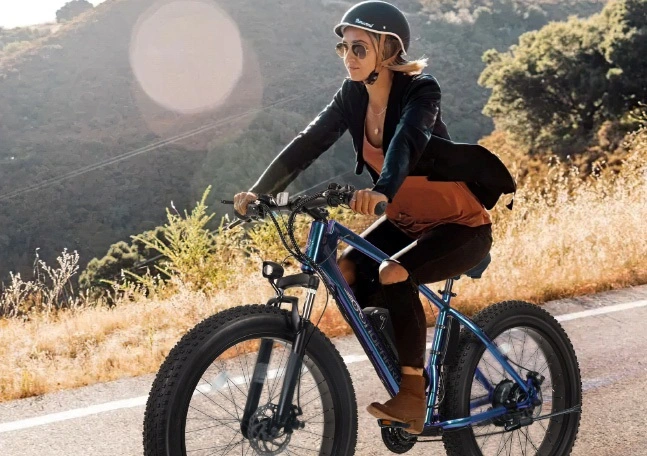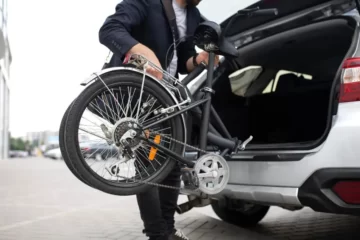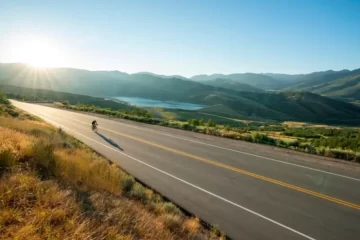Electric bikes, or eBikes, have been making a remarkable impact on commuting worldwide. With eco-conscious individuals opting for these electric wonders over traditional cars, eBikes are changing the way we move through our cities. But as these sleek machines whiz through urban streets, one question often lingers in the minds of potential eBike riders: Can they handle the challenge of steep hills?
In this article, we’ll delve into the inner workings of eBikes to reveal how they conquer even the steepest of inclines.
Can eBike go uphill?
Generally, the answer is “Yes.” In addition to being able to climb hills, certain ebikes can handle difficult terrain better than conventional mountain bikes.
It lowers the amount of energy required on steep hills for outdoor enthusiasts. And you’ll have a great riding experience if you pick the finest ebike for slopes.
Understanding How E-Bikes Work on Steep Hills
1. The Basics of Electric Bikes
Before we delve into how electric bikes handle hills, let’s briefly review how they work in general. Electric bikes are essentially bicycles equipped with an electric motor and a battery.
This motor assists the rider in pedaling, making cycling more accessible and less strenuous. The level of assistance can be adjusted to suit the rider’s preferences and the terrain.
2. Pedal Assist vs. Throttle-Controlled E-Bikes
There are two main types of e-bikes: pedal-assist and throttle-controlled. Pedal-assist e-bikes require the rider to pedal, and the motor assists in proportion to the pedaling effort.
Throttle-controlled e-bikes, on the other hand, can be operated solely by the throttle, much like a scooter. Both types can handle hills, but the way they do it differs slightly.
3. The Motor’s Role in Hills
The heart of any electric bike is its motor. When you encounter a hill, the motor comes into play to help you overcome the extra resistance.
E-bike motors are typically located in one of three places: the hub of the front wheel, the hub of the rear wheel, or the bottom bracket (the part of the frame where the pedals attach). Each location has its advantages and disadvantages in terms of hill climbing.
4. Torque Sensors and Cadence Sensors
To make hill climbing more efficient, many modern e-bikes are equipped with sensors that detect the rider’s pedal input. Torque sensors measure the force applied to the pedals, while cadence sensors track the speed at which the pedals are turned.
These sensors send signals to the motor controller, which adjusts the motor’s power output accordingly.
5. Hill Adaptive Power
One of the key features that allow electric bikes to excel on hills is their ability to adapt to changing terrain. When you start ascending a hill, the torque sensor detects the increased pedal pressure and instructs the motor to provide more power.
This ensures that you get the assistance you need to maintain a comfortable pedaling cadence and make it up the hill without exhausting yourself.
6. Battery Capacity and Range
The battery on an e-bike plays a crucial role in hill climbing performance. The more energy your battery can store, the longer you can maintain assistance on a hill. The range of an e-bike depends on various factors, including the battery capacity, the level of assistance used, and the terrain.
It’s essential to choose an e-bike with a battery that suits your needs, especially if you plan to tackle hilly terrain regularly.
7. Regenerative Braking
Some e-bikes are equipped with regenerative braking systems, which can help you conserve energy when going downhill. When you apply the brakes or coast downhill, the motor can reverse its role and act as a generator, converting some of your kinetic energy back into electrical energy to recharge the battery.
This feature can extend your e-bike’s range and efficiency, particularly on hilly routes.
8. E-Bike Gearing
In addition to the motor and battery, the gearing on an e-bike also influences its hill-climbing abilities. E-bikes often come with a wide range of gears to accommodate various terrains.
When approaching a hill, you can shift to a lower gear to make pedaling easier and maintain a steady cadence, even on steep inclines.
Features of Electric Bikes for Climbing Hills
Consider these important eBike features if you want an electric bike that can manage steep hills with ease. These factors play an important role in helping you to climb steep hills effectively on your eBike.

Let’s examine the contributing factors.
1. Large battery
On an adult-sized eBike, you’ll be climbing severe slopes, so it needs to have lots of power. It will be inconvenient and uncomfortable to ride if your e-bikes runs out of battery power in the middle of your trip. You don’t want to ascend those steep hills with low battery, in my opinion. If you’re an adventurer, you’ll need a powerful battery to climb these difficult hills.
In light of this, your ebike ought to have a big battery that can go longer on a single charge. For instance, a 52V 20ah battery enables you to pedal-assist ride for more than 80 miles on a single charge. Therefore, you don’t need to be concerned about battery life.
2. Powerful motor
Your electric bicycle should be fitted with a powerful motor if you want to conquer severe slopes. The hub-drive motor is one of the most widely used options. This kind of motor can climb hills more easily and produces torque.
The acceleration is better the higher the torque. So for difficult hill climbs the best choice is the eBike with a hub-drive motor.
3. Safety disc brakes
Safety is of the utmost importance when tackling steep terrain. Hydraulic or mechanical brakes with strong braking qualities must be included on your electric bike. They not only keep you secure but also make it possible for you to easily ascend incline hills.

Additionally, the bike’s frame plays a crucial role. Your stability and safety while riding will be impacted if your bike’s frame isn’t robust enough. Therefore, your electric bike should have a sturdy frame so that you may ride it easily over steep hills.
4. Using a tire with a strong grip
One of the most frequently forgotten eBike parts is the tire. Your e-bike’s capacity to climb has a significant impact on the tires. Finding the appropriate tire for your riding terrain is crucial.
The grip of your bike tires must be quite strong if you want to climb steep hills without struggling. We think that using an e-bike with such fat tires will make it easy for you to climb steep hills.
So, how effective are e-bikes on hills?
They significantly reduce the effort required to climb hills compared to regular bikes. You can reach the top without breaking a sweat, making cycling accessible to people of all fitness levels. However, they still require some pedaling effort, especially on steeper inclines, and the battery will drain faster uphill.
Overall, e-bikes are game-changers for hill climbing. They open up new routes and experiences, making cycling more enjoyable and inclusive for everyone.
Safety Considerations
When riding an electric bike on hills, safety is paramount. Here are some tips to keep in mind:
- Maintain control: Be sure to use the appropriate level of assistance for the terrain. Too much power on a steep descent can be dangerous.
- Keep an eye on your battery: Monitor your battery level to ensure you have enough power to make it up and down the hills on your route.
- Brake wisely: When descending hills, use your brakes judiciously to avoid overheating them. Regenerative braking can help, but it may not be sufficient on very steep descents.
- Practice makes perfect: If you’re new to riding electric bikes on hills, start with less challenging terrain and gradually build your confidence and skill.
Conclusion
Electric bikes have transformed the way we experience cycling, making it accessible to a broader range of riders and enabling us to conquer hills and steep inclines more easily. The combination of motor assistance, advanced sensors, battery technology, and smart design allows e-bikes to provide a smooth and efficient ride even on challenging terrain. Whether you’re commuting to work or exploring the great outdoors, electric bikes make hill climbing a breeze, expanding the possibilities for cycling enthusiasts of all levels.
FAQs
Can electric bikes handle extremely steep hills?
Yes, many electric bikes are designed to handle steep inclines. Higher-powered motors and advanced pedal-assist systems make conquering even the steepest hills feasible.
How far can an electric bike travel on a single charge when riding on hills?
The range of an electric bike on hills depends on factors like battery capacity and terrain. On average, most electric bikes can cover 20-50 miles on a single charge.
Are electric bikes difficult to maintain?
Maintaining an electric bike is relatively simple. Regular checks on the battery, motor, and overall cleanliness ensure optimal performance.
Can I ride an electric bike on hills without using the motor?
Yes, electric bikes can be ridden without motor assistance, functioning similarly to traditional bikes. This is particularly useful when conserving battery power.





[…] mode of transportation. One of the key advantages of e-bikes is their ability to assist riders in conquering hills with ease. But just how steep a hill can an electric bike […]
[…] The type of terrain you’re riding on greatly affects your e-bike’s speed. On flat and smooth roads, a 1000W electric bike can reach higher speeds compared to hilly or rough terrain. […]
[…] cost. The decision is yours. If you want convenience then buy a reliable battery for your e-bike. However, you can buy the tools and the battery parts if you believe they will be useful to you in […]
[…] Electric bikes are generally quiet and produce very little noise while in operation. The primary source of noise on an e-bike is usually the tires rolling on the pavement and any noise generated by the chain and drivetrain, which can be similar to that of a regular bicycle. […]
Very informative.
[…] hope this article gives you a clear picture of the pros and cons of fat tire electric bikes. Now, go forth and conquer those hills, mud puddles, and any other terrain that stands in your […]
[…] electric bikes can often pull trailers, depending on their design and specifications. Many electric bikes, especially those designed for commuting or cargo purposes are equipped with sturdy frames and […]